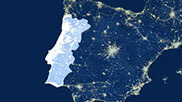Clara Gouveia, INESC TEC, Portugal
Increasing flexibility of the distribution system is key to enabling further integration of renewable-based generation while ensuring secure and efficient operation. EU Electricity Directive 2019/944 established specific rules to increase flexibility and promote coordination, incentivizing system operators to become neutral market facilitators and procure market-based flexibility services. This implies a change in distribution network operation and planning, being able to integrate third-party resources into their internal procedures and coordinate with DSO-owned assets.
From a technology perspective and excluding regulatory issues, DSO systems have two main challenges to overcome: improving the observability of the network and promoting coordinated operation of HV, MV, and LV networks.
Improving distribution network observability
Network observability requires improving the monitoring and mapping of the network as well as the capability of processing and correlating historical data from different sources (e.g. smart metering, SCADA, OMS). For example, MV and LV load diagrams provided by smart meters are key for both planning and operation, enabling more accurate long-term (years ahead) and short-term (days to hours ahead) load forecasts.
Observability is critical particularly for LV networks, considering that LV network’s topology and feeder characteristics are typically poorly characterized, and monitoring and control capabilities are limited. Again, smart metering data have the potential to improve the observability of LV networks, considering the load and voltage measurements collected. However, communication infrastructure limitations do not allow to collection of data in real-time and may require the adoption of data-driven tools that can extract knowledge from the available historical data. Their information can also be combined with other data sources with higher uncertainty (e.g. typical load diagrams), in networks with limited deployment of smart meters.
EUniversal has developed data-driven tools to improve LV network observability and self-awareness considering smart metering data and other sources of data to:
- Improve LV network characterization, identifying consumer connection phase and estimation of LV feeder electrical characteristics (e.g. resistance and reactance). The main advantage of these tools is to avoid the installation of further equipment and the mobilization of field crews.
- Voltage forecast and state estimation tools, capable of estimating accurate voltage at all nodes of the LV network, avoiding further installation of monitoring equipment.
- Congestion forecast tools, taking advantage of different sources of information, from limited network topology, typical load diagrams, and historical data from smart meters or other monitoring equipment.
Enabling Day-ahead and intraday procurement of flexibility
Regarding control capabilities, implementing flexibility market services implies a change in distribution network control strategies towards a more predictive approach, where the system to interact with market processes needs to forecast technical restrictions (e.g., voltage and congestion problems) and define the optimal operation strategy considering both network assets and flexibility resources.
EUniversal project developed a multi-level preventive management framework, consisting of a toolchain, from classical power flow to data-driven state estimation and control tools. The different tools are responsible for three main tasks:
- network state and constraints forecasting, for identifying a priori potential HV, MV, and LV network constraints (voltage violations and congestions). Main innovations concern LV networks, where data-driven tools are developed to deal with the limited monitoring capabilities and inexistent or poor characterization of the network topologies and the feeder electric characteristics. Also, DLR is adopted to forecast HV line capacity.
- flexibility needs assessment and operating envelopes, being able to quantify the flexibility needed to solve technical constraints that cannot be solved by DSO assets and operation strategies (e.g., network reconfiguration, Volt/Var control). Flexibility needs quantification considered the participation of LV flexibility to help solve constraints in MV networks, without creating additional technical restrictions at the LV networks. The tools also enable determining operating envelopes for flexibility, ensuring that LV flexibility aggregation for MV grid support does not cause any additional technical constraints.
- flexibility bids selection and validation, enabling the selection (depending on the market design) and validation of flexibility bids considering the impact of flexibility mobilization in both LV and MV networks.
Allowing aggregation is quite relevant to ensure adequate market liquidity, facilitating the participation of LV flexibility resources. However, voltage and congestion technical constraints are local problems, meaning that the contribution of the flexible resources depends on the node where the resources are connected and the quantity they can provide.
When assessing flexibility needs for solving technical constraints the project proposed the concept of dynamic flexibility zones, which identifies those nodes that can solve the technical constraint(s) and group them into zones according to their effectiveness in solving the network constraints. This concept also enables more effective DER aggregation within the LV and MV feeders, avoiding the need for DSOs to share network information with the market platforms to ensure technically viable flexibility in bid selection.
The tools developed within the EUniversal project are being tested in three pilots located in Portugal, Germany, and Poland, considering distinct data availability scenarios conditioned by different smart metering rollout statuses, regulatory frameworks, and DSO internal systems architecture. As a result, a new generation of tools for future Advanced Distribution Management Systems (ADMS) will be available for the DSOs.






